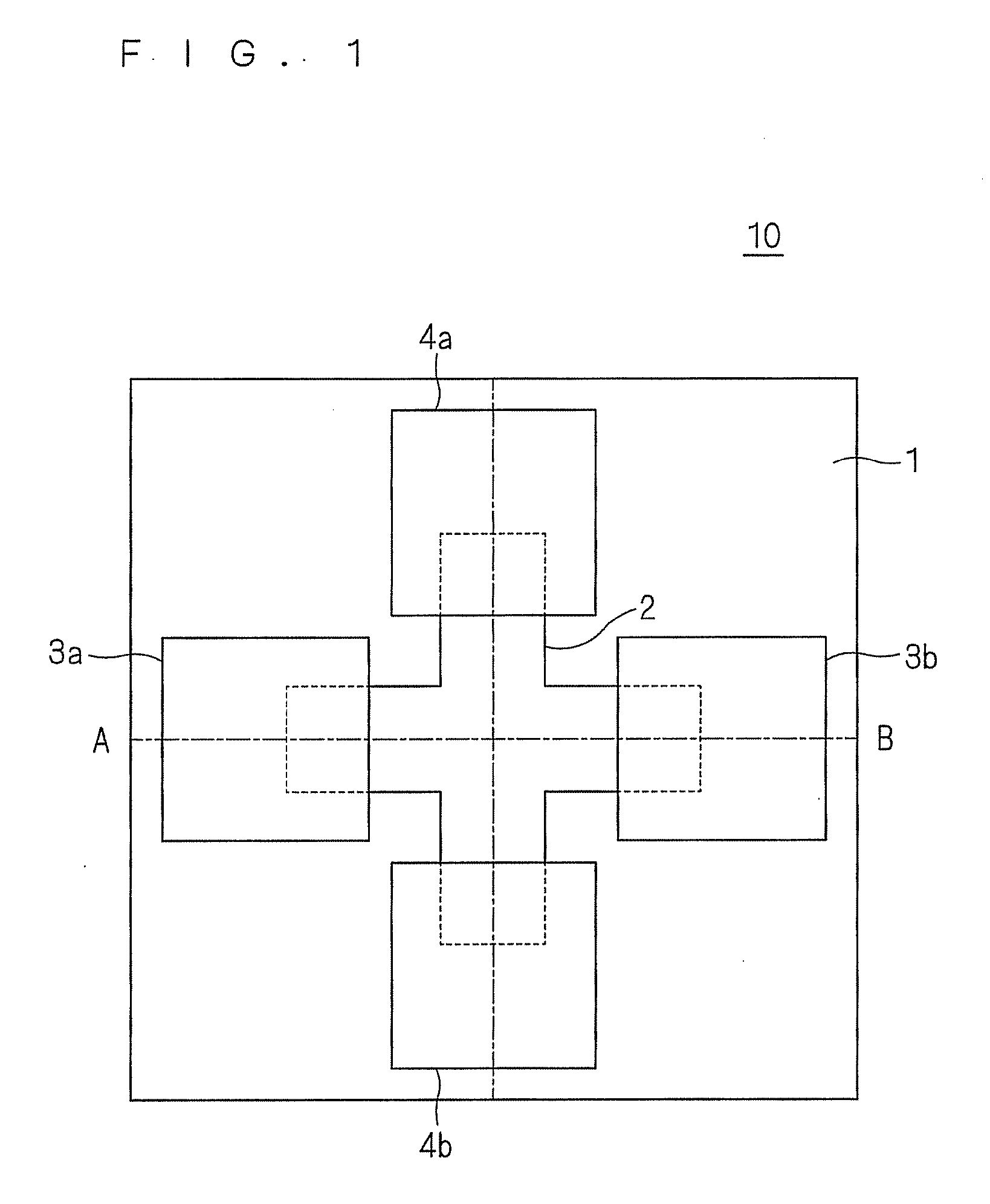Magnetic sensor, hall element, hall ic, magnetoresistive effect element, method of fabricating hall element, and method of fabricating magnetoresistive effect element
a technology of magnetoresistive effect and hall element, applied in the field of magnetism, can solve the problem that the magnetism sensor cannot be used at a high temperature, and achieve the effect of the same measurement sensitivity
- Summary
- Abstract
- Description
- Claims
- Application Information
AI Technical Summary
Benefits of technology
Problems solved by technology
Method used
Image
Examples
first embodiment
[0030]A Hall element which is of a magnetic sensor being able to detect a magnetic field by utilizing a semiconductor Hall effect will be described in a first embodiment.
(Outline of Hall Element)
[0031]FIG. 1 is a top view showing a Hall element 10 according to the first embodiment of the present invention. FIG. 2 is a sectional view showing the Hall element 10 in a section A-B (passing through a substantially central portion) of FIG. 1.
[0032]In the Hall element 10, an operating layer 2, two input electrodes 3a and 3b, and two output electrodes 4a and 4b are provided on a substrate 1. The operating layer 2 is formed so as to have a cross shape in a central portion thereof when the Hall element 10 is viewed from above. Preferably each line of the cross shape is formed with a width of tens micrometers and a length of hundreds micrometers. For example, the width is set at 50 μm and the length is set at 200 μm.
[0033]The two input electrodes 3a and 3b are provided on front-end portions op...
second embodiment
(Outline of Hall Element)
[0062]As for the Hall element 10 shown in FIG. 2 of the first embodiment, when the operating layer 2 is formed into the cross shape with the RIE technique, a part of the substrate 1 is also removed by performing the etching deeper than the thickness of the operating layer 2. The way of forming the operating layer 2 into the cross shape is not limited to such manner. A Hall element including an operating layer in a different manner from the Hall element according to the first embodiment will be described in this embodiment.
[0063]FIG. 13 is a sectional view showing a section passing through a substantially central portion of a Hall element 20 according to the second embodiment. The Hall element 20 according to the second embodiment differs from the Hall element 10 according to the first embodiment in that the height of the cross-shape portion of the Hall element 20 is lower than that of the Hall element 10, although the Hall element 20 is identical to the Hall...
third embodiment
[0073]The laminated structure 5 prepared for the fabrication of the Hall element 20 according to the second embodiment, which has the first layer 2a made of the high-resistance GaN layer whose specific resistance is not lower than 1×106 Ωcm (electron concentration is not more than 1×1012 / cm3), suitably satisfies conditions to fabricate a high electron mobility transistor (HEMT) exhibiting a good pinch-off characteristic. Accordingly, by utilizing the laminated structure 5, a Hall IC in which the Hall element according to the second embodiment and an IC unit including HEMT are integrated can be realized. The Hall IC will be described in a third embodiment.
[0074]FIG. 14 is a side view showing a conceptual configuration of a Hall IC 100 according to the third embodiment. FIG. 15 is a top view showing a conceptual configuration of the Hall IC 100 according to the third embodiment. In the Hall IC 100 shown in FIGS. 14 and 15, the components are disposed by way of example for the purpose ...
PUM
 Login to View More
Login to View More Abstract
Description
Claims
Application Information
 Login to View More
Login to View More - R&D
- Intellectual Property
- Life Sciences
- Materials
- Tech Scout
- Unparalleled Data Quality
- Higher Quality Content
- 60% Fewer Hallucinations
Browse by: Latest US Patents, China's latest patents, Technical Efficacy Thesaurus, Application Domain, Technology Topic, Popular Technical Reports.
© 2025 PatSnap. All rights reserved.Legal|Privacy policy|Modern Slavery Act Transparency Statement|Sitemap|About US| Contact US: help@patsnap.com



